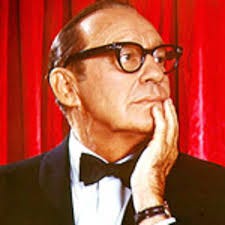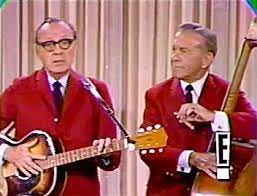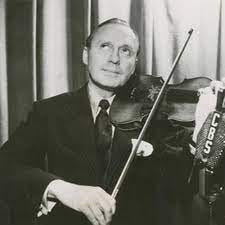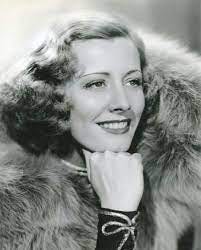He made “well!” into the funniest four-letter word in the English language, He could get a laugh with a baleful look over the shoulder or with the peevish flop of a hand. The whole world knew he was the cheapest man on the planet. The proof that Jack was the greatest of all the comedians is that everyone- EVERYONE- imitated hm.
He was one of the first stars I met when I arrived in Hollywood to write for Bob Newhart. I had material in a Broadway revue starring Carol Channing. When Carol and her husband, Charles Lowe, came to L.A., they invited my wife and me to dinner at Perino’s, which was then the number one restaurant in L.A. Their other guests were Jack and his wife, Mary, known on his radio and TV programs as Mary Livingston.
We were new to the ways and wealth of Hollywood. I noticed Mrs. Benny was sporting a huge rock on her finger. As an aside, I said to my wife, “Why would she wear such a garish rhinestone?” My wife corrected me. That was not a rhinestone.
Years later when I was on staff on THE DANNY KAYE SHOW, the first program opened with an ancient Roman procession escorting a curtained palanquin. The curtain parted to reveal Jack dressed as a Roman emperor. The mere sight of him and his attitude got the series off to a huge laugh.
We booked Jack on THE SMOTHERS BROTHERS COMEDY HOUR through two of our writers, Al Gordon and Hal Goldman, who had worked for Jack for 20 years. Through Hal and Al, we were able to book Jack along with his lifelong friend, George Burns.
Booking Jack and George was part of our strategy to win over an audience for The Smothers Brothers by associating them with established stars. Our show opened every week with a silhouette of two men standing with guitar and bass. The lights came up to reveal Tommy and Dickie. On our second show, the lights came up on the silhouette to reveal Jack with the guitar and George standing by the bass.
It was my favorite show of the series, the only one I have on DVD. It ended with a production of “WINCHESTER CATHEDRAL”. George, who loved to sing, crooned the song while Jack did a corny recitation
The next time I worked with Jack was on a Dinah Shore Special, “HOW TO HANDLE A WOMAN”. One day we shot Jack in a sketch in the studio without an audience. After the first take, the Director, with the chutzpah I can only ascribe to directors, said over the PA. “Jack, we have to do it again. Only this time, talk a little faster.” Jack, who was always cooperative, said to me, “I’ll say it faster, but it won’t be funny.”
The last time I was with Jack, he performed with the Los Angeles Philharmonic at The Dorothy Chandler Pavilion. He had just returned from a concert tour of Israel and was euphoric about his experience.
Over coffee after the performance, he told us, “Y’know, those fellas were so smart. Wherever I played, they put up photographs outside of the theatre showing me with Jascha Heifetz and Isaac Stern and Rubinstein so the public wouldn’t think I was just some schmuck with a fiddle.”
But of course, that was what he was when he started out in vaudeville as Benny Kubelsky. His act consisted of playing the violin, interspersed with moments of comedy along the way. Those moments blossomed into one of the longest comedy careers in show business—over 30 years on radio and television plus a dozen movies along the way and sold-out personal appearances all over the world.
The format of his weekly broadcast never changed. He started each show talking to the studio audience, although there was none. Jack did not need an audience to tell him where the laughs were.
The show constantly reinforced his image as a miser. We all knew he drove an ancient jalopy called a Maxwell. He kept his money in a walk-in safe in his basement. And when he was held up on the show and the hold up man demanded “Your money or your life”, there was a long pause, the funniest pause in history. The straight line had been building by the writers all those years. Finally, the hold-up man insisted, “Which is it?” The cheapest man on the planet replied, “I’m thinking it over.”
His series had a repertory cast which included Mary Livingston; his announcer, Don Wilson; tenor Dennis Day; his band leader, Phil Harris; and Eddie Anderson who played Rochester, his insolent chauffeur, butler and nemesis. They all had one thing in common: They all disrespected Jack and we loved him for it all the more. He never seemed to mind. Why should he? It made Jack a multi-millionaire.
There used to be a cohesive show business community in Los Angeles. The stars all knew one another. You could find them at Sunday dinner at Chasen’s in Hollywood. The front room was reserved for regulars like Benny and Burns, Hope, Sinatra, Milton Berle and George Jessel. They all knew one another and did guest appearances on each other’s radio and TV shows. For years, Jack and Fred Allen carried on a running feud on their shows.
Many of the comedians belonged to The Friars Club, which was notorious for their “roasts” which were, to say the least, X-rated. I heard this story about Jack Benny speaking at a Friars Club roast of George Burns.
But first, to appreciate this joke, you must know who Irene Dunne was. In the 30’s, she was the queen of screwball movie comedies, beautiful, poised, witty and elegant, the ultimate schicksa. So here’s what Jack is supposed to have said about George at the Friars Club Roast:
“I have known this fella all my life. He has done and said some terrible things, but the worst was the time he said Irene Dunne was a cocksucker.” That got a huge laugh of course, but Jack was the master of timing. When the long laughter at last died down, he added, “She denied it, of course.”
If you’d like to spend some time with Jack, read “SUNDAY NIGHTS AT SEVEN”, his unfinished memoir, interwoven with reminiscences by his daughter, Joan. Or you can always watch episodes of THE JACK BENNY SHOW on YOU TUBE.






